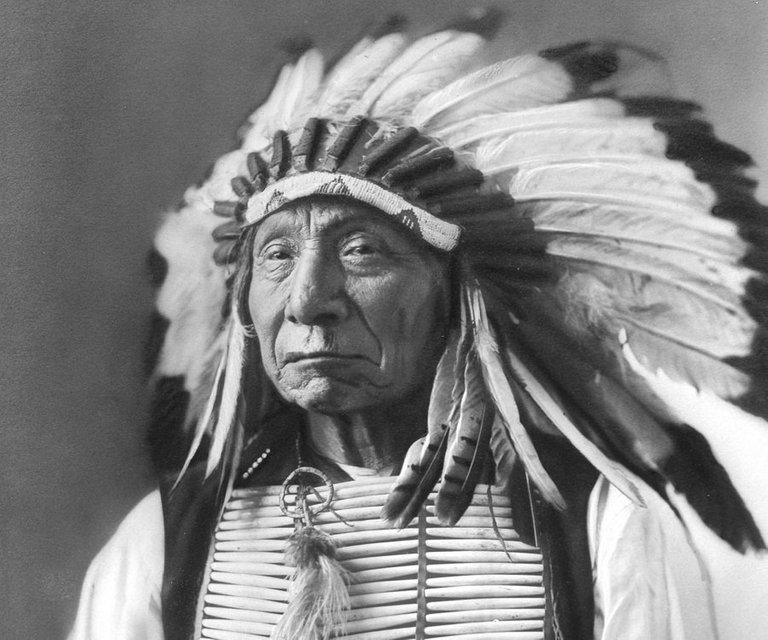
Government requires that its people fear it. The state must project power. These two statements are as true today as they have been since small groups of people began attempting to control the rest of humanity. These men and women use violence, lies, and all manner of coercion. We are constantly told that the government of the United States is the sole “super power.” Vietnam struck at the very core of this illusion when the United States government failed to obtain victory in that poor backwoods area of the world. Sure, they had excuses, but they lost. What if I were to tell you that you are unaware of a loss to an even less “powerful” nation? Just after the Civil War, we lost a war that raged right here. The war lasted from 1866-1868 and was named after one of the leaders of the victorious stateless Indian tribes who, at the time, controlled 1/5 of what is now the United States. This Freedom Fighter was Red Cloud and his Sioux and other tribes soundly defeated the U.S. Government. This great warrior is the only American Indian in history to force the Army to sue for peace on his terms.
The largest gathering of American Indians ever, were brought together in September of 1851 at Fort Laramie, which is located in present-day southeastern Wyoming. The tribes included were Arapaho, Cheyenne, Blackfeet, Crow, and many other tribes. Also among those in attendance was the feared Sioux. The only major tribe not in attendance was the Pawnee, who refused to participate because they feared the Sioux.
Among the Lakota Sioux in attendance were many names that history remembers. Sitting Bull, who at this time was virtually unknown, was already warning his people about their dependence on the white man. Also among these Sioux was an 11 year old son of a medicine man, who one day would be known as Crazy Horse. One of the most impressive figures among these gathered warriors was the 6 foot tall 30 year old Red Cloud perched atop his painted mustang.
Red Cloud had been born nearby and he knew all too well the practices of the white man and their government. At this point in his life, Red Cloud had served his band, called the Bad Faces, for almost a decade as a blotahunka, or head warrior. As he stared out at those gathered, he knew that the white men who had invited him and the others, had no notion of his stature. Every Indian present on the other hand knew very well of the power, not only of Red Cloud, but the Sioux.
The American Government had no idea how to deal with these people. At this gathering, the tribes would be bribed with all sorts of trinkets, blankets, and food. They would be asked to “sign” peace treaties that they could not read, did not understand, and knew that the white man would never honor. The government would call for their leaders to come forward. These people did not have a centralized leadership. They sometimes randomly chose someone to march forward and touch the top of the pen, so that in turn, their name would be written by an Army official. It was all a farce.
Yet, this was a farce that the brilliant tactician, Red Cloud, would use. He studied the Army’s numbers. He watched their maneuvers. Most importantly, he carefully monitored their weapons. Those within the safety of the fort thought that they were showing off their power by displaying their newest and best rifles, cannons, and other weapons to savages. What they were actually doing is familiarizing Red Cloud with their strengths and weaknesses.
White men had numbers. They also had better weapons. What they did not have was generations on generations of warriors raised to die fighting. The Plains Indians did not take prisoners. Worse than that, if you were unlucky enough to survive the battle on the losing side you would be tortured and dismembered. This applied whether you were a combatant or not. It also was your fate whether you were a man, woman, or child. The white men were not ready for this kind of butcher as an enemy.

When the Indians had signed treaties and been bribed, the American leaders thought that they had been successful when an Arapaho head man, more or less speaking for all of the tribes, said, “I would be glad if the whites would pick out a place for themselves and not come into our grounds. But if they must pass through our country, they should give us game for what they drive off.” With that the “Horse Creek Treaty,” was, “signed.” The white man would say that it would lead to “lasting peace.” The agreement would be the “most sweeping treaty the Sioux had ever signed.” It, of course, would quickly be broken. Red Cloud said publicly that he never intended on abiding by the treaty. What the idiots in charge got when they randomly chose “Chiefs” was an unenforceable agreement. The Lakota, who were the most feared tribe on the plains, were looking for new “head men,” and Red Cloud was on everyone’s short list of leading warriors.
In their book, “The Heart of Everything,” Bob Drury and Tom Clavin had this to say about the outcome of this treaty:
“No one, certainly not Red Cloud, could have imagined him (Red Cloud) a bottled spider confined to a specific territory, no matter how large or how bountiful. The idea of Red Cloud prohibited from leading raids, from stealing horses, from taking scalps- the very exploits for which he was already renowned- was opposed to his nature.”
To expect Red Cloud to follow a treaty made with what he perceived as weaker men that went against Sioux culture for time immemorial was at best, stupid and at worst, would lead to war. In this case, the worst case certainly happened to the government. They had met their match in this freedom fighter who would not permit his people to be eradicated by fools.
The Government and its Army had no idea what they were facing in the Sioux. These Indians did not weave baskets; they did not make pottery, or make jewelry. This tribe and their neighboring tribes, such as the Cheyenne, did not like farming and did little of it. What the Sioux did well was fight and kill. Their culture was similar in some ways to the Greek Spartans but was much more brutal.
The United States was actively trying to license and regulate, which are two words that the Sioux did not even begin to understand. This white man’s tribe had a reputation, as well, of not in any way acting in the best interest of other white men, much less the red man. They knew of the forced migration of Indians to Oklahoma. The Sioux saw the white men and their country as a poison setting in on their land. Red Cloud himself had seen this poison first hand. His father died of alcoholism. This caused the Sioux leader to abhor “the water that makes men crazy.”
Add to this their decentralized leadership culture. No head man of the Sioux could order any other man. Sure, they had respected leaders, but the tribe followed them because of their actions, not because of their title or tradition. Again, the US Government was at a loss to understand that to work with these people, they had to earn their respect. How could they do that when the Army constantly broke treaties and lied?
All of that being said, had the government attacked before the Civil War, the Sioux might have been defeated more easily. The military, even before the Colt revolver and other weapon innovations, would have severely outgunned them. Also, the plains tribes did not yet understand military tactics and would do little more than attack and retreat. The idea of holding ground made no sense to them. All of this changed years later when Red Cloud rose to power.
As usual, with treaty after treaty, the “The Great Father,” which is what they called the president, made promises that they and their hunting grounds would be left alone. From 1849 to 1851, just to give a snapshot, more than 20,000 wagons and over 140,000 head of livestock crossed Sioux land. They were pissed. The response of the white trespassers to this anger is captured by this quote from a white immigrant, “The Savages are foes on every hand, subtle as the devil himself.” These men were breaking the treaty at this scale, and yet, had the nerve to blame the Indians!
By 1850, when Red Cloud was only 29, the ignorance of tribal culture was already beginning to handicap the Army. They did not even begin to understand that Red Cloud was rising in the tribe. They thought him too young. At this time, among the Sioux and other plains tribes, he was undoubtedly the “most feared warrior on the High Plains.” Officially among his own band, the Bad Faces, he was of a lesser rank than Old Smoke, but in troubled times, warriors had prominence over what white men would call “chiefs.” Already, Red Cloud had become the spiritual and martial leader of his people.
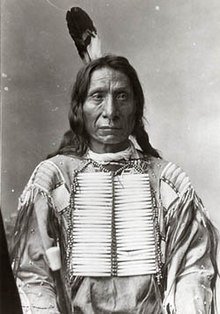
Together Old Smoke and Red Cloud kept their band safe in the north from the diseases brought by the Americans such as cholera, measles, and small pox. Other tribes and even other bands of Sioux had been decimated by these epidemics. This, as well, added to the popularity of Red Cloud.
At this time, the United States in all of its ego, decided to name a “Chief” among the Sioux. Red Cloud was still unknown to them and he had decided to keep his people away from the Forts of the white men. They picked a man named Conquering Bear. The eastern Lakota ignored the appointment. The Oglalas, including Red Clouds Bad Faces, were astounded and angry at the thought of white men choosing their leaders. Not only was this an obvious insult to them, it also was an erosion of their autonomy. Red Cloud saw it as an offense to Old Smoke, but wanted to keep peace, so he ignored the proclamation. Writing about this divide, a Lakota born historian named Joseph M. Marshall III wrote, “The whites had one truth, and the Lakota another.”
Although Red Cloud decided not to act on the insult, it was a deciding moment for him. The question of whether or not there would be conflict with the United States had been answered. The only question now, was when. Red Cloud knew he needed to stall for time. He had seen the weapons that the Army had and also knew that if the Sioux were going to win a war, they were going to need a lot more guns.
The “reign” of Conquering Bear would not last long. In 1854, an angry Sioux killed a cow that belonged to the local fort. The commanding officer demanded the offending warrior be turned over. Conquering Bear knew that was never going to happen. No Sioux would turn himself in to sit in a Blue Coat jail. Conquering Bear, as expected, did not return with the warrior.
Angry, an officer called for soldiers to go get the Indian. The officer’s view was “the white race would always trump the red, no matter the numerical odds.” It was his “Christian God’s intended order of things.” The commanding officer allowed him to raise a response. The officer took a twelve-pound field piece, a snub-nosed mountain Howitzer (a cannon), and he asked for volunteers. All forty infantrymen rose to help. He put 29 of them on horses and got the drunken interpreter onto a saddle. They then set out to find the offender.
Again, Conquering Bear tried to talk sense into them just outside of the gates to the fort. As the “Chief” turned to go back to his people, the officer ordered his men to line up. He then ordered them to fire, killing Conquering Bear.
In front of the fort, the “friendly” Sioux were camped. Everyone in the camp saw what had just occurred. The camp consisted of around 5,000 Sioux. Somewhere around 1,200 of them were warriors. The response only took minutes. “Rifle balls and clouds of arrows a thick as black flies sailed into the American line.” The interpreter, who was an avowed Indian hater, briefly escaped into a “death lodge,” whose owner had just been buried. The furious Lakota found him and drug him out. “He writhed in the dirt and wailed for mercy as they sliced out his forked tongue and replaced it with his severed penis.” When he died after his eyes were gouged out, the warriors waved their penises at him in the traditional Sioux insult. None of the other soldiers fared any better.
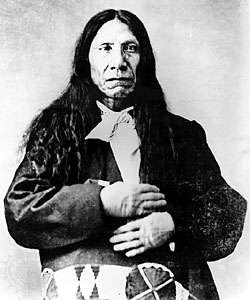
By the time the story made it to the white newspapers, it was Conquering Bear who had lured the poor soldiers into a trap. Messengers were dispatched with news that the Western Sioux had risen. Anyone who argued the truth was called an “Indian Lover.” The Lakota, including Red Cloud, on the other hand, felt that justice had been done and were not that interested in further conflict.
The following summer, Red Cloud was granted the highest honor of a Sioux warrior. He took part in what was called a “Pipe Dance.” Almost all Oglala bands attended. Although Old Smoke was still alive, in his seventies, this was a clear signal to every Sioux who was the most respected of their people. According to Drury and Claven, “The four pillars of Sioux leadership- acknowledged by the tribe to this day- are bravery, fortitude, generosity, and wisdom. Time and again, Red Cloud exhibited each.”
While Red Cloud was rising to the pinnacle of Sioux respect, the United States was talking about sending troops to put down the non-existent Sioux uprising over one cow. They were ordered that all Sioux they found should be considered hostile and killed. In late August of 1855 several Sioux, including Crazy Horse, crossed paths with the Army. The Sioux tried to parlay. The troops advanced and the outnumbered Indians fled. In all, eighty-six men, women, and children were killed. The soldiers, who wanted “revenge” over the “massacre” the year before, scalped and mutilated the bodies of the Indians. The “civilized” United States soldiers hacked out the vaginas of the women as trophies. On top of those killed, they took seventy women and children prisoner. After the battle, the Sioux called the commander of the soldiers, “Woman Killer.”
In 1856, the Sioux had finally had enough. For four decades they had been lied to, hunted, and put up with trespassers. They had seen the white man name their own leader of the natives and then, they saw the Army shoot him in the back. Worst of all, they had seen their sacred Buffalo, which they considered the soul of their people, dwindle as the white traders skinned them and left the rest to rot. It was time for the Sioux to stop fighting other Indians and fight the Whites.
Red Cloud, in the shadow of the Black Hills, started uniting, first the Sioux and then other tribes of the plains. He noticed an up and coming warrior who had shown himself to be a good leader. Crazy Horse had a future in the growing Sioux warrior society. For the first time in history, all of the Lakota were being summoned to a great council where they would formulate a united resistance against the threat of the United States government.
The estimated attendance of Indians at the council in 1857 was over 10,000. Red Cloud asked one simple question as they debated whether they were going to go to war, “When had they ever known the whites to be satisfied with the lands that they already possessed?” The united strategic objective that emerged was that their people must be protected, by force if necessary. Red Cloud dispatched Crazy Horse to visit other tribes. Red Cloud stopped raiding and began looking for better methods to destroy his enemy. One thing that he was certain of was that if a large scale engagement against the Blue Coats were to occur, his people would lose. He needed to weaken their opponent. When they attacked, it had to be strategic, not simply random attacks.
The best help for Red Cloud’s plans to unite his people happened in 1861, the Civil War. While the North and South were fighting each other, they would not be able to attack Sioux. They went back to fighting weather and bickering, but they largely did not kill.
In addition to most troops being pulled from the west, the government in its wisdom reminded the Lakota who their enemy was now and then. As part of their treaties, the government had promised the Dakotas, Sioux cousins of the Lakota in Minnesota, provisions such as food in the harsh winters. They, of course, failed to deliver, causing widespread starvation. The opinion given by the whites was “If they are hungry, let them eat grass.” This need for food caused the Dakotas to attack the poorly manned forts. They were put down.
The Dakotas claimed that they were offered leniency if they surrendered. Over 1,200 warriors turned themselves in. Most were handed long prison sentences. More than 300 were ordered to be hanged. Red Cloud used this to bring his cousins into the fold.
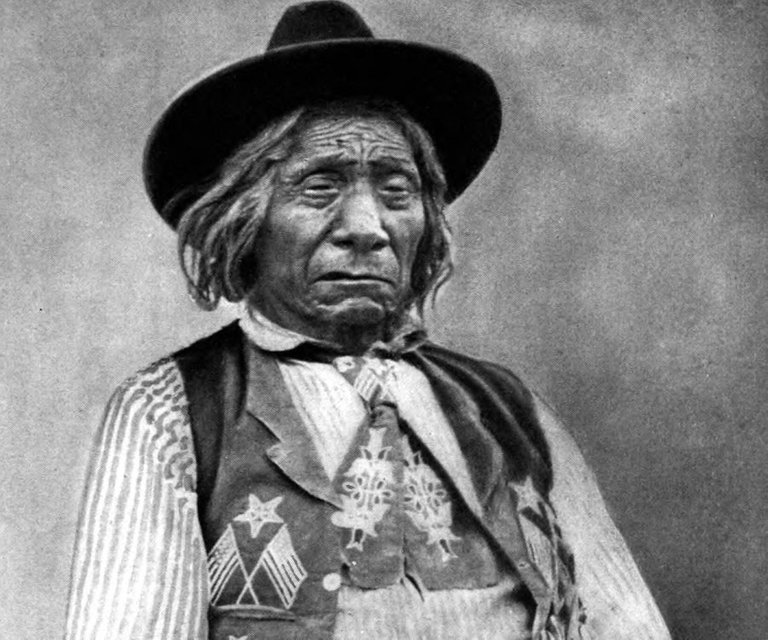
Red Cloud was not alone. Aside from Crazy Horse, who had become his primary warrior; Sitting Bull in 1865 had soaked the plains red with the blood of white men as well. War was on the horizon. The Plains Indians had used the Civil War to gather their allies and prepare for the certain return of soldiers who now had seen war. In this time, Red Cloud also grew as a tactician. The newly arriving officers described the Indian presence as ghosts. They never saw them but knew that they were everywhere.
The white men may not have known where the Indians were, but the Sioux certainly knew where the whites were. With the influx of quicker guns, they were busy wiping out the sacred heart of the Plains Indians, the Buffalo. In one day, a hunter could kill over 100 buffalo. In four decades the population of the animal reduced from somewhere around 30 million to less than 1,000. Sitting Bull said, years later, “A cold wind blew across the prairie when the last buffalo fell. A death wind for my people.” The most offensive part for the Lakota was the fact that the white men only took the tongue and hide. The rest was left to rot on the ground. This was blasphemy. It was like spitting on Mother Earth and the Great Hoop of existence!
If the United States Army had been more aware of the situation, they would have attacked one tribe after another, but instead they attacked them all. Most commanders did not know the difference between a hostile and friendly Indian, much less a Cheyenne, Arapaho, or the various kinds of Sioux. This drove these tribes and bands into Red Cloud’s building Army.
Red Cloud had tried to put off the eventual clash, but by spring of 1865, he knew that the conflict was on his doorstep. It was time to fight the United States. He convened a war council of many tribes, most were Cheyenne and Sioux. They were uniting under one common cause, their survival. The speech that Red Cloud delivered was simple.
“The Great Spirit raised both the white man and the Indian. I think he raised the Indian first. He raised me in this land and it belongs to me. The white man was raised over the great waters, and his land is over there. Since they crossed the sea, I have given room. There are now white people all about me. I have but one small spot of land left. The Great Spirit told me to keep it.”
Red Cloud’s promise was simple. “If white men come into my country again, I will punish them again.” It was his plan to close down the pathway into his people’s land, forever.
With the influx west of seasoned soldiers, there were advantages and disadvantages. Sure, these soldiers knew war, but they also were sick of it. Many soldiers either just did not show up to fight the Indians, or were spurred on by other reasons, like the newly found gold on the plains.
The war with Red Cloud was at a bad time for the United States, who were not that united. Even when the Army won battles it was expensive. One comment made in Washington after seeing the cost of the new war was this, “Another such victory and we are lost.” The cost of war with Red Cloud was estimated at $24 million a year. That is $3.2 Billion a year in today’s currency. So the United States decided to offer another treaty, but in the usual government brilliance, they did not mention that they were going to do so to the War Department. The generals wanted dead Indians and painted with vivid colors how many dead ones they wanted, all of them. They set out to kill every man, woman, and child. Genocide was their goal. As usual the Government promised the red man peace and delivered war.
As the attacks on Plains Indians continued, their way of life was destroyed. They faced starvation and death. Again Red Cloud rose to bring them together. The US government had organized another treaty. This is what Red Cloud said directly to them at the signing:
“The Great Father (the president of the United States) sends us presents and wants a new road, but the White Chief (the Commander of the Army) already goes to steal the road before the Indian says yes or no. I will talk with you no more. I will go now, and I will fight you. As long as I live I will fight you for the last hunting grounds.” War had been declared.
Historian, Stephen E. Ambrose described warfare on the plains as similar to naval warfare. He said that the Army “was lumbering around with battleships and cruisers, chasing pirates in sleek fast vessels.” He compared the forts to home ports where the large ships needed to stop for supplies. The Indians were like pirates living off the sea. They needed no port.
Red Cloud now had thousands of warriors riding with him. His plan, as usual was simple. The whites snaked across his land in large trains of wagons. He would cut off that serpent’s head. He began attacking the forts, especially the ones under construction. Unlike his predecessors, Red Cloud had learned complex tactical strategy. He could attack with multiple bands simultaneously. Each band might have a different goal, and acted largely independently.
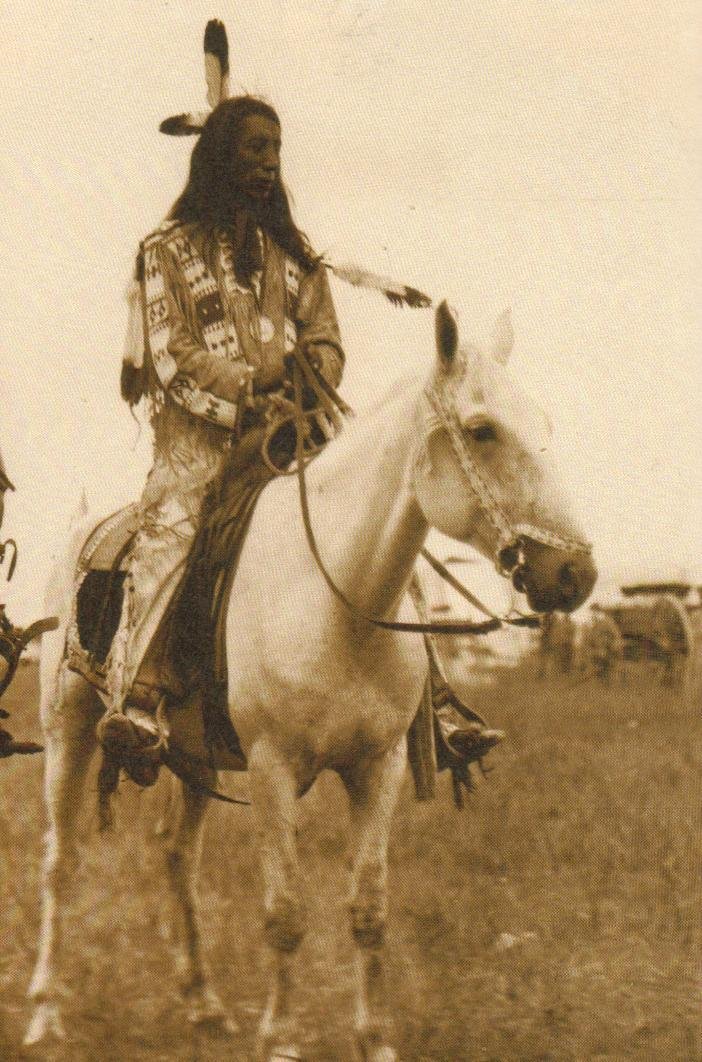
In the past, most reports of the frontier painted a rosy picture. The commanders sometimes asked for reinforcements, but they wanted promotions and therefore, tried to diminish most of the trouble. That had changed. This is an example of a report given in 1866. It starts with this quote, “Character of Indian affairs hostile.” He asked how he could be expected to build forts, fight Indians, and protect 500 miles of road with limited resources. I will summarize the report.
July 29- 8 soldiers killed by Indians
August 6- 2 civilians killed by Indians
August 7- Indians attacked wood train 2 civilians killed
August 12- train attacked Indians running off most of cattle and horses
August 13- Indians attacked wood trail again no one killed
August 14- 2 civilians killed by Indians
August 17- garrison attacked, Indians stole 7 mules and 22 horses
September 10- Indians stole 42 mules, Army gave chase, while away Indians stole 33 horses, and 78 mules
September 12- Indians attack killing 3 soldiers and wounding 6
September 13- Indians stole 209 head of cattle
September 14- two soldiers killed, hay bale machine destroyed all hay burned.
September 22- “The scalped, stripped, and mutilated bodies of 3 civilians were found” just outside of fort
As you can see, this one report was bleak. Red Cloud was in the words of historian Grace Rice, “a strategic chief, who was learning to follow up on victory, an art heretofore unknown to the red man. Army patrols were in unknown lands fighting a vicious enemy who now had learned how to fight them. When they did manage to chase off hostile Lakota, they would be facing a secondary attack.
In response, General Sherman, the second highest ranking member of the army, penned a letter to the commanding officer in the plains, Colonel Carrington. Sherman had taken a tour of the area and had seen the problem first hand. He said to Carrington, “We must try to distinguish friendly from hostile and kill the latter. But if you or other commanding officers strike a blow, I will approve, for it seems impossible to tell true from false.” His message was clear, because they could not tell them apart and had no idea who was lying, kill them all. The result of this letter was that all of the soldiers were ready to attack any Indian. The first victims were a band of friendly Cheyenne. Of course, this flooded Red Cloud with more recruits.
The war was not going well for the Americans. Unlike his white counterparts, Red Cloud could make decisions and execute them within minutes. Also, his warriors could continue an assault even if their leaders were killed. The decentralized system of leadership used by Red Cloud and his warriors was certainly quicker than the cumbersome government system of commands and ranks. The tactical and strategic genius that was Red Cloud was simply running circles around Carrington.
The morale in these forts was at an all time low. Constant loss of life was all around them. They had a graveyard outside of the fort and it had many occupants. None of them died of natural causes. They watched as chopped up bodies were brought in and buried. On one occasion, a man was scalped and was allowed to escape with the top of his head removed, he made it to the fort and died. At one point, a group who were less than 10 miles from the fort was overwhelmed by Sioux and voted to kill themselves instead of be captured by these red demons. Fear might be the tool of government but it can bring all men to their knees.
As the military set out in their new fort to make statements, they would be facing an enemy trying to make no other point but to destroy its foe. Carrington had decided to construct a massive flagpole in the center of the fort. The pole was a 124 foot tall and held a 20 x 26 foot American Flag. They wanted the flag to be a comfort to approaching caravans. After it was erected, they played music, cheered, and fired off weapons. After the celebration, the troops were given the rest of the day off. Two hours later, they were recalled to duty when Indians were spotted on the horizon.
By chance, a large group of Sioux happened to be passing by. They were curious what all of the commotion was about; among them were Crazy Horse and Red Cloud. This commotion inspired Crazy Horse, who devised a plan. He had seen that all of the soldiers were following the direction of particular soldiers. These soldiers were easily discerned from the other soldiers. They had many big flashy medals, or what now would become targets.
On December 3, 1866 President Andrew Johnson gave his second State of the Union address. The hour long speech barely mentioned the war in the west or the frontier in general. He said that the army was restoring “peace, order, tranquility, and civil authority.” He continued with, “Treaties have been concluded with the Indians, who, enticed into armed opposition to our Government at the outbreak of rebellion, have unconditionally submitted to our authority and manifested an earnest desire for a renewal of friendly relations.”
Three days later, Red Cloud enacted the plan formulated by Crazy Horse. Just outside of the most important fort in the west, they lured a large part of the experienced enlisted soldiers and all but Carrington out of the fort on a chase. The Sioux killed them all, every calvery officer was among them. They now had no leadership. Most of the officers were dead, along with them, anyone who had served in the west more than a few months. This was just the dress rehearsal that would soon take down the United States Army.
Red Cloud put together a huge war party consisting of, Lakota, Cheyenne and Arapaho. They set up camp around 10 miles north of the American post. He set up scouts on the hills overlooking the fort. It was his plan to trap the Americans on the flats of a little valley inside a leafless dogwood thicket, big enough to hide his forces. They waited for the right moment.
It came when the snow melted enough to hide their tracks on December 21st 1886. As the soldiers out on patrol saw the hostile Indians, they gave chase. Crazy Horse stopped just out of rifle range. He pretended that his horse had been injured. This wiry young warrior yelled insults at the soldiers and taunted them. Finally, he pulled down his leggings and showed them his bare ass. They took the bait, and all hell was unleashed. The over 2,000 Plains Indian warriors descended on the soldiers. After 40 minutes, every Blue Coat would be killed.
At the fort, after they did not return, Carrington dispatched the remaining 40 men with a howitzer. They reached their position too late. To give a number to the battle, over 40,000 arrows were recovered. In a dispatch, immediately sent, Carrington described the loss as “a fight unexplained in Indian warfare.” He went on to say that without immediate support, retaliation was impossible. The only thing that saved the lives of the remaining men and women at the fort was a blizzard that arrived around midnight. The mighty United States Army was cold, scared, and defeated.
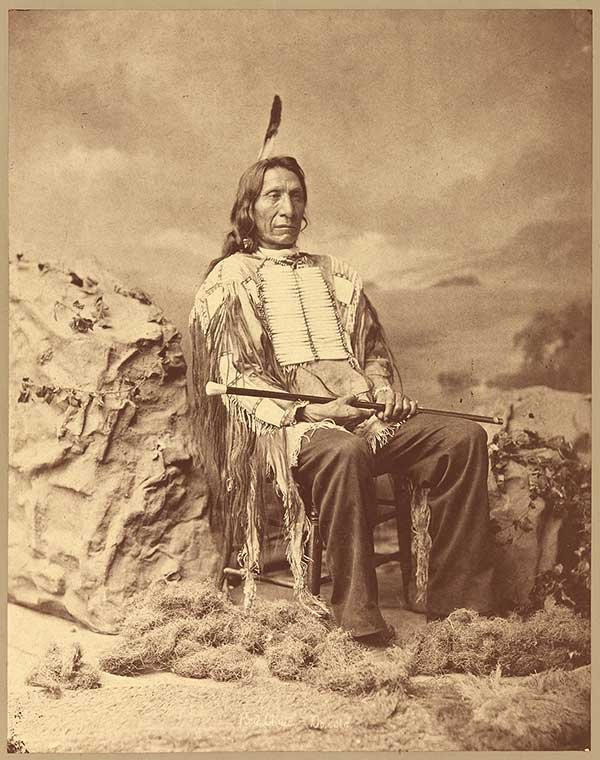
At the celebration that would follow in the Indian camp, two men were honored. Crazy Horse, who had led the battle was usually silent in preparation. Now he would be inducted into tribal leadership and Sioux, Cheyenne, and Arapaho would look to him in the future because though they had won this war they knew the ways of the white man. They would need another leader in war.
Red Cloud’s stunning victory at Fort Laramie would solidify his legend. He had put tribal disputes aside and united the plains Indians. His military genius had defeated the invading Americans. The cause of his people had been just, to live. Best of all to his people the ground before the Blizzard was covered in white as far as the eye could see. The white was not snow, but the piled bodies of his people’s enemies.
This war would not officially end for another year. He would simultaneously attack Forts Kearney and C.F. Smith and kill everyone in them. A General in the War Department said that to defeat the Lakota they would need 20,000 soldiers, something they could not afford. In the end, the government would sue for peace on Red Cloud’s terms.
The terms were simple. Red Cloud insisted that the trail through his land be closed forever and the three forts within it be abandoned before he even considered peace. The Army was shocked. They arrived in April, 1886 to negotiate. Red Cloud refused to attend. A month later, they agreed to his terms. Still he waited; he had heard the white man’s promises before. The last week of August the last of the American soldiers and civilians had packed up. Red Cloud’s people burned the forts to the ground. On November 6th 1868, the Bad Face Oglala Lakota Sioux warrior rode to triumphantly sign the peace treaty. It was the proudest moment of Red Cloud’s life.
Of course Red Cloud’s victory would be short. From within his own people, Sitting Bull would refuse peace. Many others would eventually join him, including Crazy Horse. As has been shown time and again, government never honors its promises.
Red Cloud, in June of 1870, accepted an invitation from newly elected President Ulysses S. Grant to tour D.C., and meet with the leaders of the country he had defeated. Red Cloud would see the future on that tour. He saw that what the violent government wanted, it would eventually get. He said, “Now we are melting like snow on the hillside, while you are growing like spring grass.” Using the last of his influence, he tried to slow the oncoming expansion. He also made a simple oath, “I shall not go to war anymore with whites.”
In 1874, gold was discovered in the sacred Black Hills. It gave Washington all the rationalization it needed to break another treaty. Though Sitting Bull would defeat General Custer at Little Bighorn, the victory was one battle in a war he would lose without the strategies of Red Cloud. Even Crazy Horse saw the futility of the new war and turned himself in. He would eventually be murdered by the guards.
On July 4th 1903, the 82 year old Red Cloud made his last speech to his people.
“My Sun is set, My day is done. Darkness is stealing over me. Before I lie down to rise no more, I will speak to my people. Hear me my friends, for it is not the time for me to tell you a lie. The Great Spirit made us, the Indians, and gave us this land we live in. He gave us the buffalo, the antelope, and the deer for food and clothing. We moved our hunting grounds from the Minnesota to the Platte and from the Mississippi to the great mountains. No one put bounds on us. We were free as the winds, and like the eagle, heard no commands. Shadows are long and dark before me. I shall soon lie down to rise no more. While my spirit is with my body the smoke of my breath shall be towards the Sun, for he knows all things and knows that I am still true to him.”
Red Cloud died December 10, 1909.
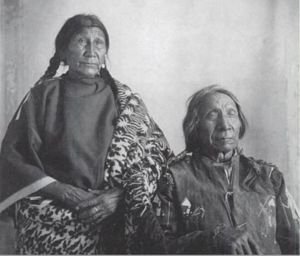
To this day, the Lakota Sioux live in the 2nd poorest county in the United States. The life expectancy of a Lakota Sioux male today is 48. They have 80% unemployment. 61% of Lakota children are below the poverty level. The United States government continues to destroy this once proud and free people, they have become dependent on hand outs. Those supplies and help promised by this government continue to not be delivered; they have never and will never honor a treaty for long. Bob Drury and Tom Claven point out that really Red Cloud’s war continues. When the treaty was broken and the Army took the Black Hills from the Lakota, they did not sign a peace treaty. The government has offered them money and the Lakota said, “No, we do not want your money, we want the Black Hills back.”
I have worked on this Forgotten Freedom Fighter post for longer than any other. Some of that is because I knew little about Red Cloud to begin with. The main reason is because it was hard to read. On so many occasions I have held up these men and women as heroes. I abhor violence. Red Cloud and the Sioux were masters of violence. This Freedom Fighter knew that government only respects and understands fear. He used it to win his war against them. What he came to realize is that fear will not set people free. The way forward towards Freedom must come without bloodshed. I know that so many say that trying to avoid the title of Terrorist. The difference is that I mean it. If we are truly to evolve past the need of the State, we must cast aside its weapons- fear, coercion, control, and violence. In its place we must raise Compassion, Peace, and above all other thing Love. With these tools, we will confuse the central planners and defeat their ministers of pain. We will evolve. I respect and have come to admire Red Cloud, not for his war, but for his undying love of his people and his efforts to keep them free.
By @marcus.pulis (Press Secretary)
Sources
“The Heart of Everything,” Bob Drury and Tom Clavin
https://en.wikipedia.org/wiki/Red_Cloud
I find the history of your country very interesting, like many other countries, its beginnings always focus on disputes with the Indians and people who abuse power, so independence begins, reading this helped me a lot to understand why it is important to know the history, Teach to open your eyes and have your own judgment.
I loved reading this story, Native Americans fought a lot for their customs that had from generations to generations, it is true what you say they had wild ways to resolve conflicts but you have to take into account where they come from and where they live, they were that way because they were in contact with the wild nature. anyway I want to congratulate you for such an implacable article. Greetings
I am glad you enjoyed this post. Red Cloud through this article has become important to my own activism.
Story is best..Very interesting article! Will be keeping an eye on your lessons, as JS is one of my less mastered languages, and you seem to have an excellent hold of it. Great work, and please keep it up!
Real freedom is spiritual freedom
wow nice concept sir..i like this..thanks for share your inportant concept.